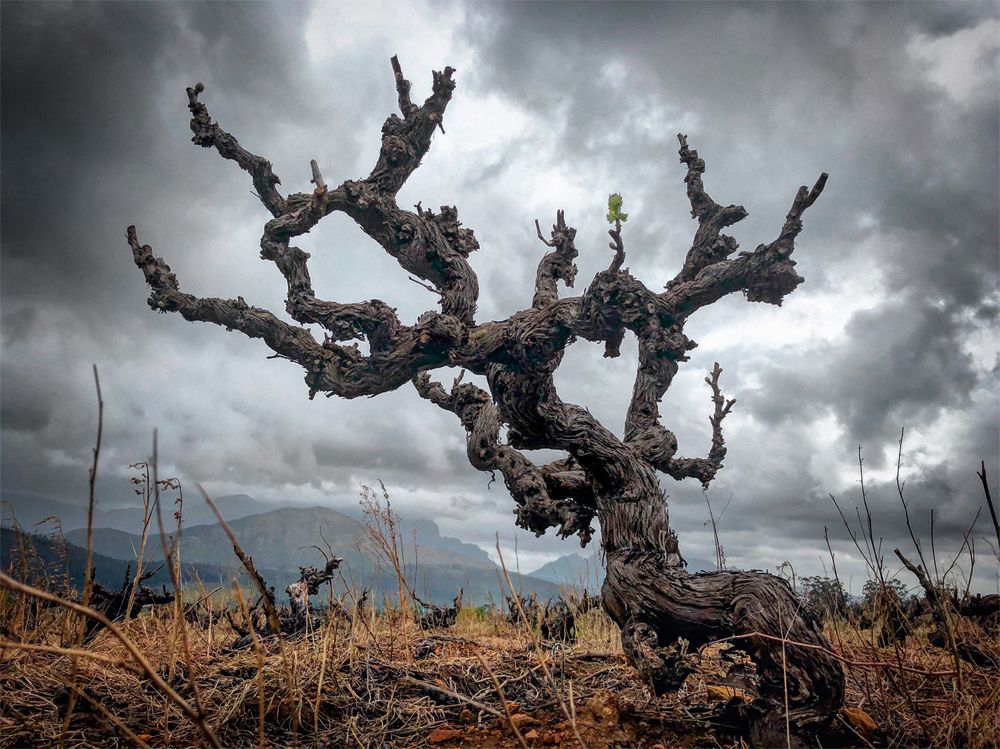You can download the full Stellenbosch Business report produced in partnership with Stellenbosch Wine Routes here.
A key element in the on-going transformation of the South African wine industry has been how quickly wine producers, and particularly younger generation winemakers, have embraced the initiative to nurture old vines back to life in a bid to make more textured, layered and complex wines.
The idea of working with old vines is nothing new, but South Africa can lay claim, in late 2016, to starting what it says is the first formal organisation, The Old Vine Project, tasked with plotting, saving and promoting old vines across the country – which it defines as being 35 years or older.
An initiative that has been given the full support of the Stellenbosch Wine Routes and its membersas the region is home to the largest number of old vines in South Africa– 857 hectares out of a total of 2,621 hectares. It is also now working with the OIV to use the standards set by the Old Vine Project as part of a global benchmarking scheme.
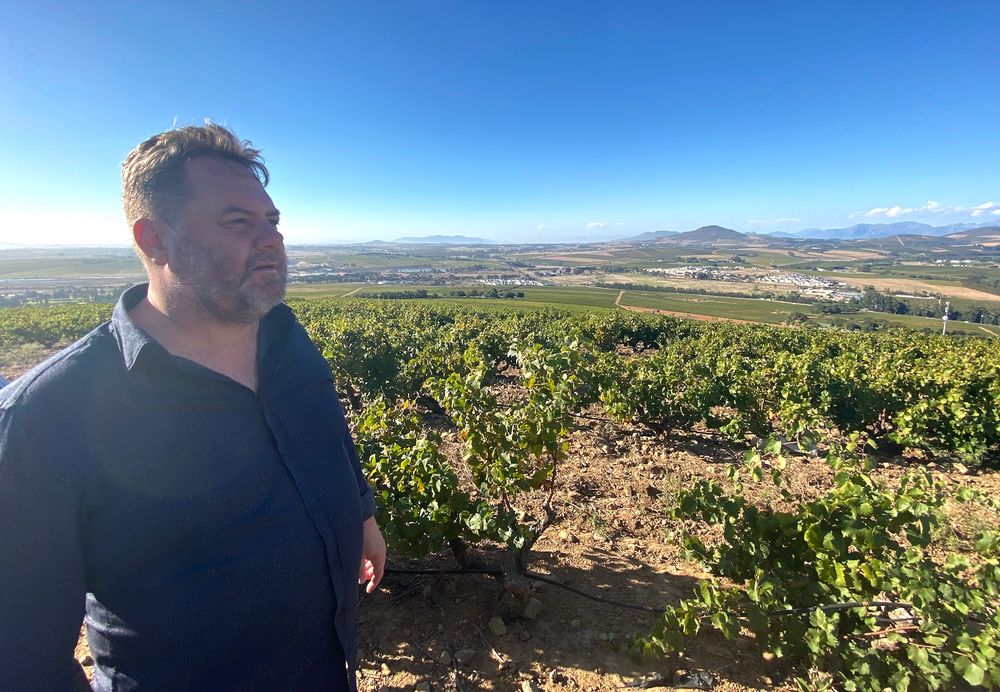
André Morghental has helped drive the Old Vine Project in South Africa and provided a benchmark for how to protect old vines for regions around the world
André Morgenthal is the beating heart of the Old Vine Project having helped start the initiative with leading viticulturists Rosa Kruger and Jaco Engelbrecht. He says: “We have created our own wine category. Restaurants now have old vine sections on their wine list. We are very proud of what we have been able to achieve in such a short period of time.”
The project has now identified 39 different old vine varieties in South Africa, of which Chenin Blanc is by far the biggest accounting for 52%. It is made possible by the records kept by SAWIS (South African Waste Information System) that records every vine planted going back to 1900.
For an estate as embedded in Stellenbosch history as Delheim, that can trace its land on the south-western slopes of Simonsberg mountain back to 1699, the Old Vine Project is also in tune with its own heritage, says director, Nora Sperling-Thiel. “It’s how we can tell our authentic story,” she says.
Delheim’s winemaker, Roelof Lotriet, says the connection between “the family and the vineyard” is so strong in Stellenbosch and it is that bond which makes its wines so special. “You are able to work with the same vineyard to try and make things better,” he adds. “The old vines are like having an old uncle on the farm who can tell you their stories.”
Doubters to believers
Morgenthal says a key role for the Old Vine Project has been to persuade farmers, particularly the larger producers and co-ops, that have many old vine vineyards within their membership, to bring them onto the programme. To do that it has set a minimum recommended fee of R10,000 per ton for fruit taken from a certified old vine vineyard to prove they can be more commercially viable than ripping them up and replacing them with seemingly more profitable alternatives.
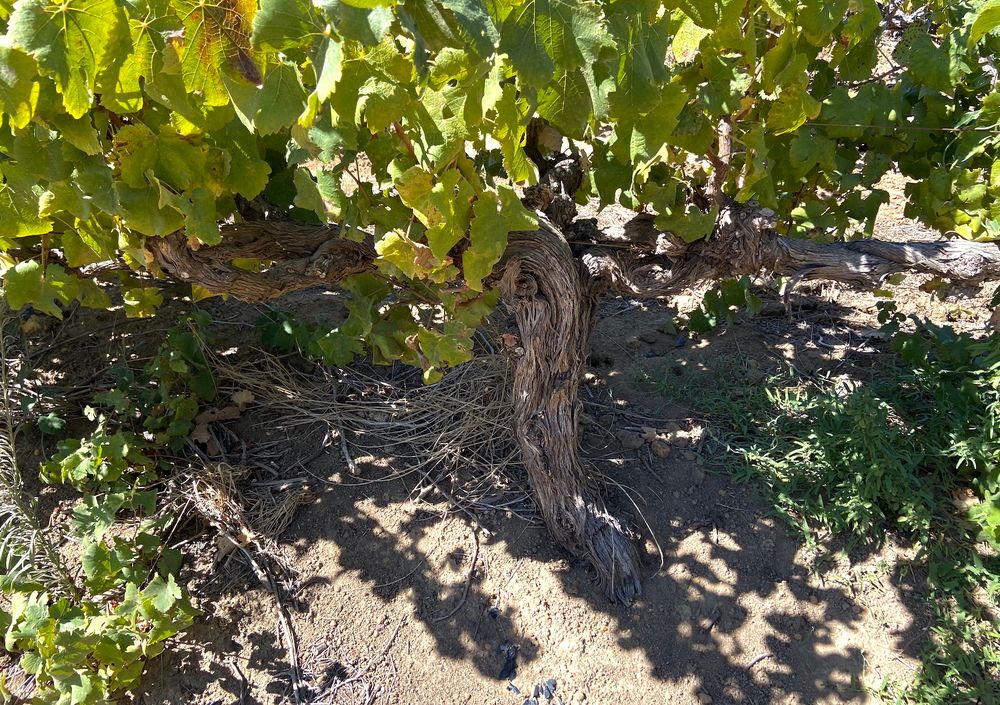
The Old Vine Project works with producers – particularly co-ops – to first identify and then help them bring old vines back to life
“Some were initially very skeptical,” he says. “The first two years were tough. It has taken a lot to convince producers as they did not believe in the concept and it was hard to develop a business concept that did not exist anywhere else in the world. We went to all the New World countries – Napa, Barossa Valley, Argentina – and no-one could give us an answer as to how to make old vines a commercial proposition.”
He adds: “But we have slowly been able to show the benefits of the scheme and how our members are willing to pay a premium for old vines fruit and they have a chance to do something with it. We have most of the co-ops on board now.”
“The Old Vine Project has now progressed from looking to save old vines, to giving growers and producers a new commercial business model through which they can create a new revenue steam. Primary growers with old vines can get up to three times more for their grapes”, says Morgenthal.
Koelenhof Winery & Bottling is one of the largest co-ops to really embrace the Old Vine Project. Managing director, Andrew de Vries explains why: “Our growers now see the value in getting their vines to 35 years old and then benefiting from the premium price they can get for their grapes.”
Some of the region’s biggest producers have a key role to play. None more so than Kleine Zalze that can lay claim to being one of the biggest handlers and buyers of old vine Chenin Blanc in Stellenbosch. Buying in up to 600 tonnes of certified old vine Chenin fruit a year.
Crucially, Kleine Zalze is willing to buy at block or parcel price for these grapes, rather than by the tonne in order to “take on the risk” that comes with working with old vines.
New lease of life
Old vines have also given a new lease of life to some of the region’s oldest and more traditional producers. Kaapzicht’s Danie Steytler says he is so pleased they did not pull up all the old vines in what was six hectares of 1947 Chenin Blanc vines, the second oldest Chenin in the region. The hectare that remains is now “making better and better Chenins year after year”.
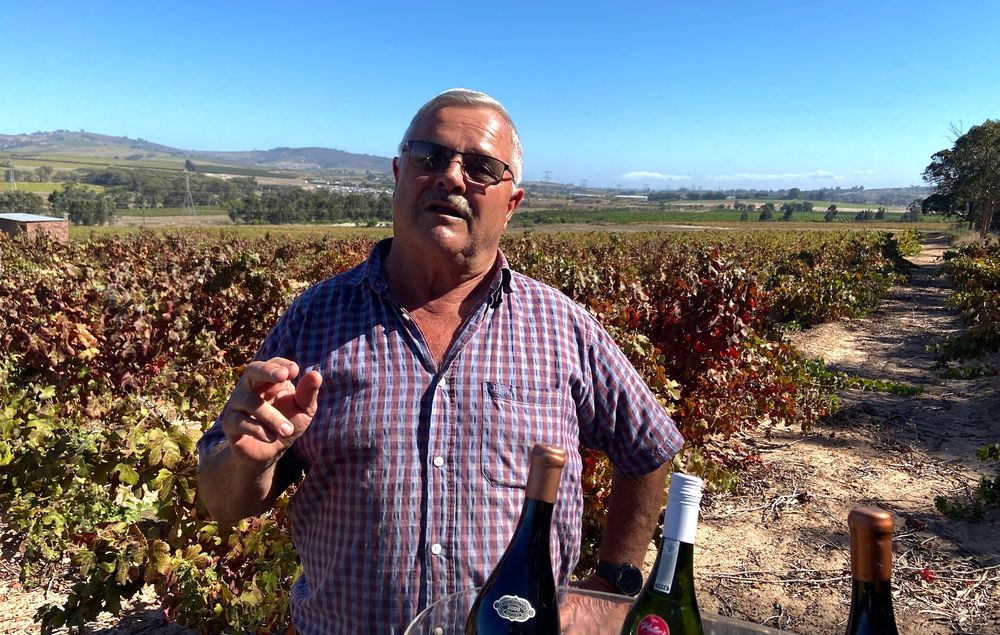
Dirkie Morkel says working with old vines means balancing the fruit and handling different parcels carefully when fermenting and blending
Bellevue is producing some of the most elegant Pinotage and Cinsaults in the region thanks to its 1955 vines, says owner, Dirkie Morkel. But it is a delicate balancing act. “You have to be cautious. I am getting around three and a half tons per hectare in order to keep that level of quality in our Pinotage. I have learnt over the years what you can get from different parcels and which soils contribute the most. To use push downs rather than pump overs, and have a colder fermentation. It’s less hands-on winemaking.”
The more Stellenbosch winemakers work with old vines, the greater knowledge they can share with each other about what approaches work best for which varieties.
Like pruning. Jeff Grier, cellar master at the family-owned Villiera Wines, says he works with Italian consultants who have transformed the pruning system it uses to “ensure the long term security of the vineyards”. “We are using the branching system in our old vine vineyards and are getting bigger yields as a result.”
Rijk Melck, owner of the Muratie Wine Estate that dates back to 1685, is very aware of his position as simply a custodian of this ancient property and its vines “that each have their own story to tell”.
It has also allowed many of the younger, ambitious winemakers in the region to forge personal ties with growers to source specific plots of grapes they know will help them make the kind of breakthrough wines they want to produce, adds Morgenthal.
Case Study 1
Koelenhof: How co-ops are growers are working together
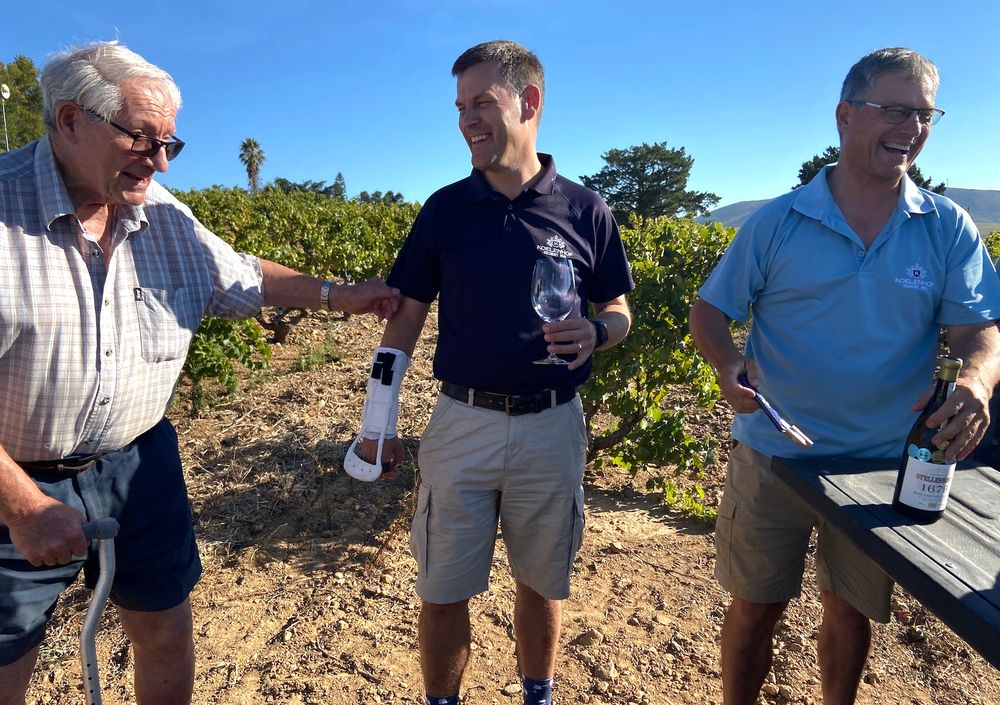
Koelenho’s Andrew de Vries, centre, has worked with local growers and members of its co-op, Francois and Gawie du Bois from Sonop, to produce the 1679 brand made from their old vines
Koelenhof Winery & Bottling is one of the key co-ops in Stellenbosch that has gone on to achieve great success by embracing the Old Vine Project and identifying the small plots of land, within the 15,000 tonnes of grapes it receives from its 70 growers, that would be suitable for making premium quality old vines.
Its 1679 brand, for example, has been recognised as one of the leading old vine wines in the region with its Chenin Blanc, Pinotage, Cabernet Sauvignon, and Bordeaux blend.
“We mainly sell our grapes to major producers, but we also wanted to do something for ourselves,” says managing director, Andrew de Vries. “The old vines have allowed us to have a super-premium wine in our portfolio. It has unlocked the potential of some of the vines our growers have.”
What makes its 1679 wines stand out is they come from vines, grown at around 285m to 300m by the Sonop farm, on the shale based slopes of the Bottelary Hills. Its success has seen many leading, younger winemakers come calling looking for parcels of fruit for themselves.
“It’s very special for us to be involved,” says Gawie du Bois of the three generation family grower. “We have passed these vines like a baby between us.”

It’s a family affair: The three generations of the du Bois winemaking family
It has certainly encouraged De Vries and his team to see where they might be able to source other old vines within its members and if there are any “undiscovered gems out there”.
“Working with the Old Vine Project helps us to be more segmented with the growers we have,” he adds. “We can grade our growers more effectively in terms of what they get paid for their grapes and identify the plots that have the most potential. Once you get old vine status you can double the money you receive for your grapes.”
Case Study 2
Longridge: Old vines, biodynamics and site selections
Jasper Raats, managing director and cellar master at Longridge, has been able to integrate how he works with parcels of old vines with his biodynamic winemaking practices to both embrace site specific wines, made with a natural philosophy. Old vines make complete sense to a winemaker that looks down into the soils for his inspiration.
“We look down to make our wines from the soils up, and then look up at the sky and the influence it has,” is how he puts it. Combining the two is very much at the heart of the super quality wines that Longridge produces.
Raats believes the focus on old vines is all part of a wider mission for Stellenbosch, and South Africa as a whole, to be truly recognised for the world-class wines it is making.

Jasper Raats explains his biodynamic practices on his Longbridge farm
It is making growers, producers and winemakers think far more about their sites and which plots, down to individual vines, are the most important in making the best possible wine you can. It’s even more critical when you are following natural and biodynamic winemaking techniques, he adds.
He says working with old vines does require different disciplines. Like pruning – and patience. “You have to prune back less than normal,” he says. “You are wanting to encourage shoots to grow further down the trunk. It takes a long time. It helps if your vision is for the next 30 years and not the next three.”
The old vine project can only work, he adds, if producers are being paid the price they need for identifying the right vines, clones and plots of land capable of producing super quality fruit but in much smaller yields. “Just because your vineyard is old, does not mean it is to going to make the best quality wine.”
He is certainly benchmarking his own wines at a premium level, like his Misterie, which he believes can sit alongside Petrus in Bordeaux, or Masseto in Tuscany. Not bad for a producer that 11 years ago was selling all its grapes to bulk.
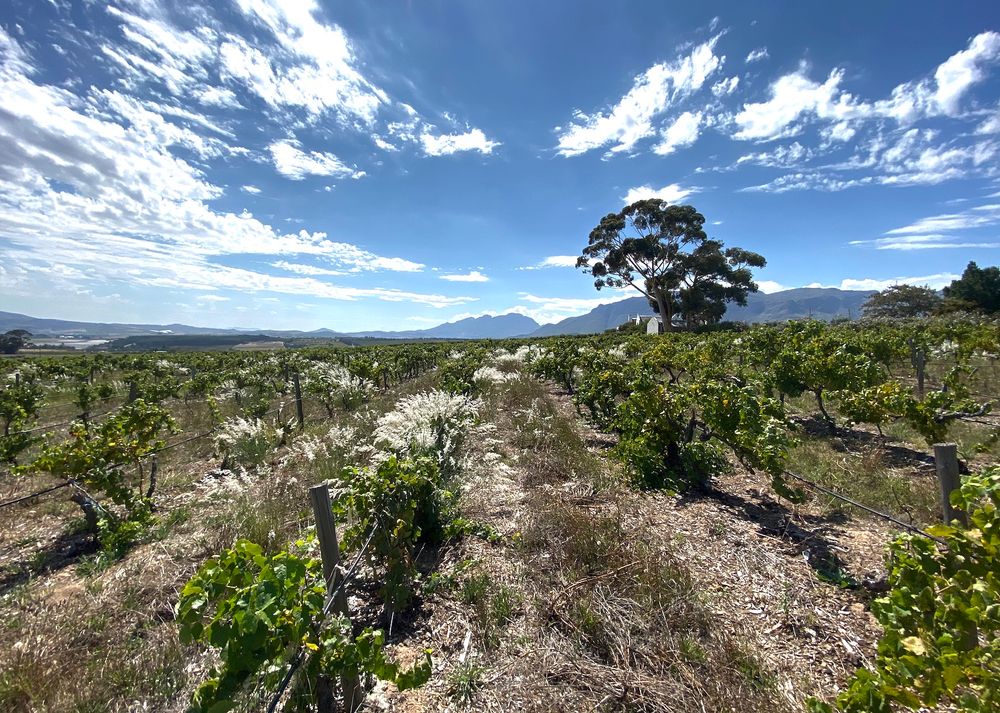
Flora and fauna and old vines are all part of the winemaking at Longbridge
Raats was first convinced by biodynamics whilst working and making wine in New Zealand. “They are light years ahead of South Africa when it comes to biodynamics and organics,” he says.
Some 10 years later and Raats is as familiar with the right breed of cows, types of grass, lucerne and fynbos to help work the fields and provide the much needed compost as he is with the grapes on his old vines.
“Everything we produce goes back into the soils. You want to get to the point when you have created your own biodiversity system and natural habitat. This farm is a living organism, where everything is working together for a common goal and has its own role to play.”
It means its old vines roots dig deeper and its soils retain up to 30% more moisture, essential during months of drought.
